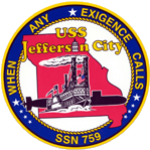About USS Jefferson City (SSN 759)
Meaning of the Seal
 The Jefferson City (SSN 759) seal reflects the ship's ties to the state of Missouri and to her namesake city. The ship's name is printed in bold letters with a picture of the Missouri state capital building rotunda, the prominent Jefferson City landmark, substituted for the "O". The central feature of the seal is a side profile of a submarine and a passenger and small packet Missouri River steamboat. The steamboat represents the IATAN which ferried Union troops across the Missouri River to occupy Jefferson City in 1861 when Confederate forces threatened to seize the city's federal armory. The steamboat and submarine superimposed over the state of Missouri represents the significance of naval vessels, IATAN and Jefferson City to the history of Missouri and the City of Jefferson.
The Jefferson City (SSN 759) seal reflects the ship's ties to the state of Missouri and to her namesake city. The ship's name is printed in bold letters with a picture of the Missouri state capital building rotunda, the prominent Jefferson City landmark, substituted for the "O". The central feature of the seal is a side profile of a submarine and a passenger and small packet Missouri River steamboat. The steamboat represents the IATAN which ferried Union troops across the Missouri River to occupy Jefferson City in 1861 when Confederate forces threatened to seize the city's federal armory. The steamboat and submarine superimposed over the state of Missouri represents the significance of naval vessels, IATAN and Jefferson City to the history of Missouri and the City of Jefferson.
The motto is derived from Thomas Jefferson's first annual message to the Congress in which he identified the nation's need to have naval forces "IN READINESS WHEN ANY EXIGENCE CALLS THEM INTO USE."
The City of Jefferson
Nestled along the banks of the winding Missouri River is the City of Jefferson, the official name of Missouri's state capital. Nearly equidistant between St. Louis and Kansas City, Jefferson City was carved out of virgin timberland donated by the federal government to establish a state capital in the early 1820s.
Named after the Nation's third president, Thomas Jefferson, the city was planned and laid out by Daniel M. Boone, son of the famous pioneer, and Major Elias Bancroft. Lots went on sale in 1823, and many of the early families to settle were friends and associates of Jefferson, and came from Charlottesville, Va. The town was incorporated in 1825, and its first mayor, Thomas Lawson Price, a young Virginian, was elected in 1839.
The first Capital Building was completed in 1826, and housed the state's executive, legislative and judicial functions. The second floor served as the governor's living quarters until the first Executive Mansion was built in 1834. In 1837 the capital burned and was replaced by a building on the site of the current Capital.
While the early Jefferson City settlers came primarily from Virginia, Tennessee and Kentucky, a number of German emigrants settled there after 1840. The German influence is seen today in the architecture and use of brick trim and stone houses, and for years the community was called the "Town of Brick".
The Civil War had an impact on Jefferson City. Missouri was the most northern state with predominately southern sympathies. While the State Convention chose for Missouri to remain in the Union, Governor Claiborne Jackson favored secession, and he called for 60,000 volunteers to form a state militia to enforce his plans. Jackson led the volunteers to Boonville, Mo., where Confederate troops were being formed. In the meantime, Union soldiers took possession of Jefferson City, and camped right on the Capital grounds.
A Confederate force of 20,000 soldiers and heavy artillery entered Missouri from Arkansas to capture Jefferson City. The troops camped along a nearby ridge for three days while residents hastily built fortifications and prepared for the battle. But on October 7, 1864, General Sterling Price suddenly and without explanation withdrew his Confederate soldiers and moved them west and away from the city. The city had been spared from open conflict.
Recovery from the Civil War was slow in Jefferson City. However, the city saw a building boom in 1870. A series of two-story flats on what was Main Street, and a French-Italian mansard roofed building which now serves as the Governor's Residence was built. The mansion is one of the best examples of this type of architecture in the country.
From the beginning, the focus of Jefferson City has been on state government. That is true today as the Capital Building dominates the city's skyline, and the largest employer in Jefferson City is the state government, which has approximately 14,000 employees in the city. A state penitentiary which was started in Jefferson City in 1833 now encompasses four detention facilities there with more than 4,500 inmates.
Jefferson City, located in the heartland of America, has stood the test of time. Over the years, it has demonstrated its strength and resourcefulness -- a proud legacy for the first Navy ship to bear its name.